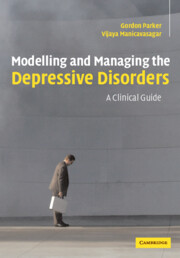Book contents
- Frontmatter
- Contents
- Acknowledgements
- Introduction
- Part I The current model for depressive disorders and its impact on clinical management
- 1 A declaration of independence
- 2 Defining and diagnosing depression
- 3 Depression sub-typing: independence and interdependence
- Part II The diagnosis and management of melancholic and psychotic depression
- Part III An introduction to non-melancholic depression
- Part IV Modelling and managing the non-melancholic depressive disorders
- Appendix 1 The DMI-18 and the DMI-10
- Appendix 2 The CORE system of measuring psychomotor disturbance
- Appendix 3 The temperament and personality measure
- References
- Index
3 - Depression sub-typing: independence and interdependence
from Part I - The current model for depressive disorders and its impact on clinical management
Published online by Cambridge University Press: 17 August 2009
- Frontmatter
- Contents
- Acknowledgements
- Introduction
- Part I The current model for depressive disorders and its impact on clinical management
- 1 A declaration of independence
- 2 Defining and diagnosing depression
- 3 Depression sub-typing: independence and interdependence
- Part II The diagnosis and management of melancholic and psychotic depression
- Part III An introduction to non-melancholic depression
- Part IV Modelling and managing the non-melancholic depressive disorders
- Appendix 1 The DMI-18 and the DMI-10
- Appendix 2 The CORE system of measuring psychomotor disturbance
- Appendix 3 The temperament and personality measure
- References
- Index
Summary
‘Taxonomy is described sometimes as a science and sometimes as an art, but really it's a battleground’.
— Bill Bryson (2003, p. 319)The expatriate Australian psychiatrist, Barney Carroll, wrote that to understand depression is to understand psychiatry (Carroll, 1989). ‘Depression’ presents the greatest challenges and the greatest risk of hubris. It is a fantasy to imagine that a clear-cut typology either exists or can be readily derived, and the road to that castle is littered with numerous classificatory systems, variably proposed by observant clinicians and/or opinionated academics. The opinionated are now regressed to the mean by Consensus Committee processes, a theoretically constructive strategy but one that is disappointing in practice because of their reliance on formal evidence-based data while their risk-free ambience tends to reify the orthodox.
The previous chapter considered how ‘clinical depression’ can be defined, differentiated (phenomenologically from grief and anxiety), and diagnosed – all relatively straightforward issues in comparison to this chapter's domain. Here we seek to tackle a more difficult task: considering whether meaningful depressive disorders can be differentiated or cleaved from each other, whether such differentiation is absolute or a matter of degree (i. e. independence or interdependence), and then present a differentiated model (of ‘meaningful’ depressive conditions) which, we argue, allows differential treatment approaches to be provided on a more rational basis.
It is in our nature as human beings to seek simple models to assist us through life and, if a simple taxonomy did have explanatory power, we would all be most appreciative.
- Type
- Chapter
- Information
- Modelling and Managing the Depressive DisordersA Clinical Guide, pp. 21 - 28Publisher: Cambridge University PressPrint publication year: 2005
- 1
- Cited by



